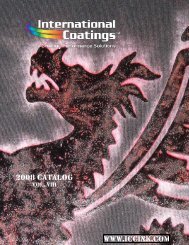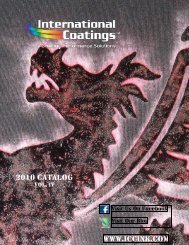2008 CATALOG WWW.ICCINK.COM
2008 CATALOG WWW.ICCINK.COM
2008 CATALOG WWW.ICCINK.COM
Create successful ePaper yourself
Turn your PDF publications into a flip-book with our unique Google optimized e-Paper software.
INTERNATIONAL COATINGS TRANSFER PRODUCTS<br />
COLD PEEL TRANSFERS<br />
International Coatings Multipurpose, 700, 1100 or 500 Series Plastisols can be used to make cold peel<br />
transfers. The inks should be printed straight from the container on a coated, cold peel release paper. The most<br />
common cold peel paper used is known as T-75, Transfert-75 or French paper. Parchment paper can also be used<br />
especially where it might be helpful to be able to see through the paper. Parchment paper is best suited for 1-color<br />
transfers as this paper shrinks considerably when heated. When ordering paper for cold peel transfers, make sure to<br />
specify cold peel application. Inks can be printed through a 61 to 160 monofilament screen mesh. The screen mesh<br />
used depends on design detail and ink being used. Glitter inks should be printed through 16T to 25T monofilament<br />
mesh for best results. The gelation temperature for Multipurpose, 700 and 1100 Series inks is 225°F to 275°F<br />
(107°C to 135°C). The gelation temperature for the 500 Series inks used as a cold peel ink is 180°F to 225°F (82°C<br />
to 107°C). Use a 60 to 70 durometer squeegee with a sharp to rounded edge. The squeegee edge used depends on<br />
the ink being printed, detail of design and ink deposit required. Colors for cold peel transfers can be overlapped,<br />
because the ink is not split when applied. Poor adhesion and/or elongation (stretch) may result from over gelation of<br />
the inks. Adhesive powders, such as International Coatings # 304 powder adhesive, can be sprinkled on wet ink and<br />
gelled, for better adhesion to some problem fabrics such as polyester. Make sure to brush off excess adhesive from<br />
gelled transfer, to prevent adhesive spotting on dark fabrics. Quick Trans 500 additive can be added to the cold peel<br />
inks to give a little better release and a softer hand. The ratio is 6 to 8 parts ink to 1 part 500 additive. Completed<br />
transfers are applied at 350°F to 375°F (178°C to 191°C), for 10 to 15 seconds, medium pressure. Cold peel<br />
transfers, when made correctly, can be very durable. If they are not, it is usually because of over gelation or poor<br />
application procedures. Since the entire ink film is removed from the cold peel transfer when applied, they are not<br />
as breathable and soft as most hot peel hot split transfers.<br />
FOIL TRANSFERS<br />
There are two adhesives that are recommended for making foil transfers. 3801LF 1 is a plastisol foil<br />
adhesive and is used for making foil applications on cotton, cotton/polyester blends and 100% polyester fabrics.<br />
3901LF is a water-base foil adhesive. It can be used on cotton, cotton/polyester blends and on some nylons, Lycra-<br />
Spandex, and leather. It is important to test adhesion and durability of these products before beginning a production<br />
run. Both of these products can also be directly printed to the garment for foil applications.<br />
3801LF-plastisol foil adhesive should be printed through a 60 to 110 monofilament screen mesh. Use a 65<br />
to 70 durometer squeegee with a sharp edge. The ink, when used for making foil transfers, should be printed on the<br />
dull, silver side of the foil, mirror image. Gel the ink on the foil at 250°F to 275°F (121°C to 135°C). Since this is a<br />
heat activated adhesive, gelation temperatures are not as critical as with hot peel transfers. Application temperature<br />
is 325°F to 350°F (163°C to 178°C). Try 325°F (163°C) first, for best results. Application time is 10 to 15 seconds.<br />
Wait till transfer cools before removing foil carrier sheet. When doing the foil application as a transfer only, it is<br />
suggested that the garment be preheated for 5 seconds before the transfer is applied. This will remove any moisture<br />
from the fabric. For more information on 3801LF Foil Adhesive see International Coatings' product bulletin<br />
3801LF.<br />
3901LF water-base foil adhesive should be printed through a 60 to 86 monofilament screen mesh coated<br />
with a water-resistant stencil or emulsion. This product can be air-dried or heat cured at 250°F (121°C). The ink,<br />
when used for making foil transfers, should be printed on the dull silver side of the foil, mirror image. 3901LFwaterbase<br />
adhesive will dry quickly in the screen if left unattended for any time. Leave screen flooded with<br />
adhesive between prints and use International Coatings 416 or 415 Retarder on warm days. Immediately clean the<br />
1 LF denotes lead free.<br />
3<br />
122




